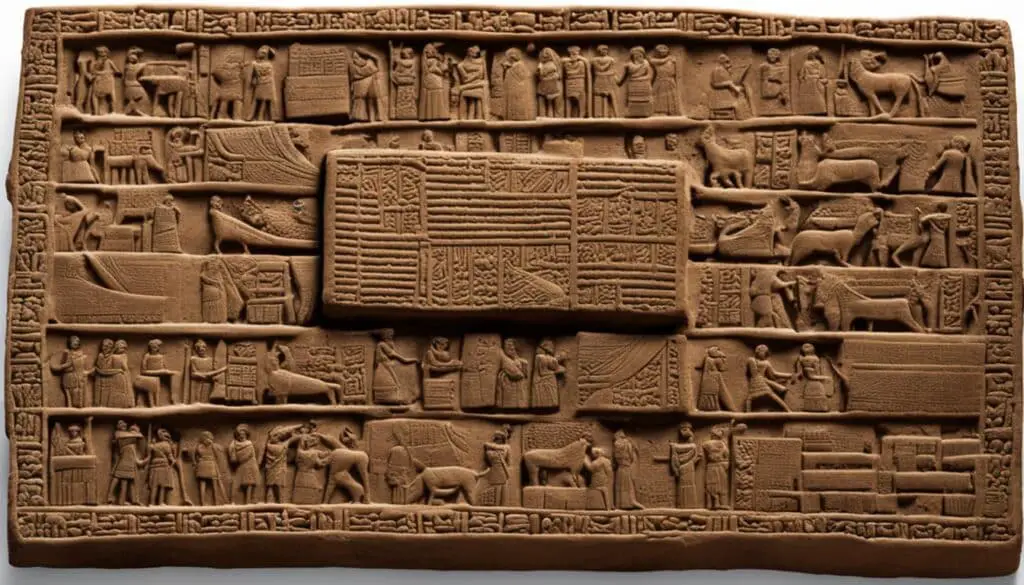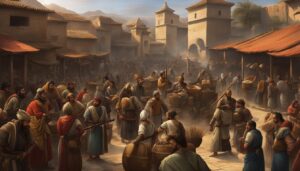
Archaeological discoveries in the ancient Near East have revolutionized the study of the Scriptures, providing historical and religious backgrounds for interpreting the Bible. These discoveries reveal a close relation between Israelite religious practices and the religious milieu of the ancient Near East. Similarities can be found in linguistic terms, such as the use of certain titles and phrases, as well as in religious ideas and social institutions. Understanding ancient Middle Eastern culture is essential for a comprehensive exploration of the Bible.
- Ancient Middle Eastern culture provides valuable context for interpreting the Bible
- Archaeological discoveries reveal connections between Israelite religious practices and the ancient Near East
- Linguistic similarities between the Bible and ancient Middle Eastern languages provide further evidence of cultural connections
- Exploring ancient Middle Eastern culture enhances our understanding of the historical and religious context of the Bible
- The study of ancient Middle Eastern culture through the Bible is a fascinating and enlightening endeavor
Parallels between Ancient Near Eastern Practices and the Bible
When exploring the rich tapestry of ancient Middle Eastern culture, it becomes apparent that there are numerous parallels between the practices and beliefs of this region and the narratives found in the Bible. These similarities provide valuable insights into the historical context in which the Bible was written and shed light on the interconnectedness of ancient civilizations.
One area of similarity lies in the linguistic connections between Hebrew, the language of the Bible, and other Northwest Semitic languages. Certain titles and terms used in the Bible have cognates in other ancient Near Eastern languages, indicating shared cultural influences. This linguistic overlap highlights the interconnected nature of the region and showcases the exchange of ideas and concepts.
In addition to linguistic parallels, there are also significant similarities in religious practices and beliefs. For example, the concept of a warrior God, capable of intervening in human affairs, can be found in both ancient Near Eastern religions and the Bible. The practice of erem, or wars of extermination, which is mentioned in the Bible, has also been observed in the context of pagan deities. These similarities demonstrate the cultural and religious connections between the ancient Near East and the biblical narrative.
By examining these parallels, we gain a deeper understanding of the cultural and historical foundations of the Bible. It allows us to appreciate the universal themes and enduring truths present in the ancient texts, while also recognizing the unique aspects that differentiate the biblical narrative from its contemporaries. The interconnectedness between ancient Middle Eastern practices and the Bible provides a fascinating glimpse into the rich tapestry of human history.

Ancient Near Eastern Influence on Biblical Narrative
“It is through the exploration of ancient Middle Eastern culture that we can truly grasp the depth and complexity of the biblical narrative. The similarities in linguistics, religious practices, and beliefs between the ancient Near East and the Bible unveil a shared heritage and emphasize the importance of understanding the cultural context surrounding the biblical texts.”
| Parallel | Ancient Near Eastern Culture | The Bible |
|---|---|---|
| Warrior God | Ancient Near Eastern religions depicted deities as powerful warriors who could intervene in human affairs. | The Bible portrays God as a warrior who fights on behalf of His people and intervenes in history. |
| Erem | Pagan deities were believed to command their people to engage in erem, or wars of extermination. | The Bible mentions erem as a practice commanded by God in specific circumstances. |
| Linguistic Connections | Hebrew, the language of the Bible, shares similarities with other Northwest Semitic languages in terms of certain titles and terms. | The use of specific titles and terms in the Bible has linguistic connections to other ancient Near Eastern languages. |
Through these parallels, it becomes clear that the Bible is deeply rooted in the cultural milieu of the ancient Near East. These connections enrich our understanding of the biblical narrative and highlight the wide-ranging impact of ancient Middle Eastern culture on religious traditions. It is through such exploration, comparative analysis, and cultural context that we can fully appreciate the profound influence of the ancient world on the development of the Bible.
Jesus and the Middle Eastern Context
Understanding the Middle Eastern context is crucial for interpreting the life of Jesus. Cultural and historical factors provide valuable insights into the events surrounding Jesus’ birth and the significance of his teachings. By exploring the ancient Middle Eastern culture and its influence on the Bible, we gain a deeper understanding of Jesus’ life and the context in which he lived.
One aspect of Middle Eastern culture that sheds light on Jesus’ birth is the concept of hospitality. In the Middle East, hospitality is highly valued, and guests are welcomed with open arms. This cultural norm is reflected in the biblical narrative of Jesus’ birth, where he was not born in a stable as often depicted, but rather in a family home. This suggests that Jesus’ birth was not a solitary event, but rather a communal celebration with relatives present to welcome and support Mary and Joseph.
Additionally, understanding the significance of family and lineage in Middle Eastern culture helps us grasp the importance of Jesus’ genealogy. The biblical genealogies highlight Jesus’ connection to the lineage of King David, emphasizing his royal heritage. In the Middle East, lineage and family ties carry significant weight and shape one’s identity and social standing. Recognizing this cultural context allows us to appreciate the importance placed on Jesus’ ancestry.
The role of shepherds in the biblical narrative also holds cultural significance within the Middle Eastern context. Shepherds were often considered to be of low status in society, and their presence at the manger where Jesus was born reinforces the idea of Jesus’ humility and his identification with the marginalized. This cultural detail underscores the universal message of Jesus’ teachings, emphasizing the inclusivity and compassion that he embodied.

Table: Cultural Influences on Jesus’ Life
| Cultural Aspect | Significance |
|---|---|
| Hospitality | Jesus’ birth in a family home reflects the Middle Eastern value of welcoming guests with open arms. |
| Family and Lineage | Jesus’ genealogies highlight his connection to the lineage of King David, emphasizing his royal heritage within Middle Eastern culture. |
| Role of Shepherds | Shepherds’ presence at Jesus’ birth emphasizes his identification with the marginalized and his message of inclusivity and compassion. |
Unearthing Ancient Middle Eastern Culture Through the Bible
The Bible serves as a captivating gateway to the multifaceted culture of the ancient Middle East. Through the lens of archaeological discoveries and cultural studies, we can unravel the interconnectedness between the biblical narrative and the customs, beliefs, and practices of the ancient Near East. This exploration not only deepens our understanding of the historical context in which the Bible was written but also offers profound insights into the rich tapestry of biblical culture.
Biblical archaeology has provided us with invaluable artifacts and evidence, unveiling numerous striking similarities and connections between the Bible and the ancient Middle Eastern world. These parallels offer a glimpse into the everyday lives of the people who lived in this region thousands of years ago, shedding light on their social structures, religious practices, and societal norms.
By delving into biblical archaeology and Middle Eastern history, we can piece together the puzzle of ancient civilization. The Bible acts as a roadmap, providing crucial clues that guide us in unearthing the mysteries of the past. Through this exploration, we gain a profound appreciation for the cultural heritage that has shaped our present world and a renewed understanding of the timeless wisdom imparted by the scriptures.
Embarking on a journey through the ancient Middle Eastern culture embedded within the Bible is a truly enlightening endeavor. It allows us to bridge the gap between the distant past and our modern society, fostering a deeper appreciation for the historical and cultural intricacies woven into the tapestry of human existence.
FAQ
What is the significance of ancient Middle Eastern culture in interpreting the Bible?
Ancient Middle Eastern culture provides historical and religious backgrounds for understanding the Scriptures. It reveals similarities in language, religious practices, and social institutions, which enhance our interpretation of the Bible.
What are some similarities between ancient Middle Eastern practices and the Bible?
Linguistic similarities can be observed in the use of titles and terms. Religious parallels include the concept of a warrior God, belief in divine intervention, and the practice of wars of extermination. These similarities highlight the cultural and religious connections between the ancient Near East and the biblical narrative.
How does understanding the Middle Eastern context contribute to our understanding of Jesus’ life?
Cultural and historical factors, such as the concept of hospitality, the significance of family and lineage, and the role of shepherds, shed light on the events surrounding Jesus’ birth. By exploring the Middle Eastern context, we gain a deeper understanding of Jesus’ life and teachings.
What does the study of ancient Middle Eastern culture reveal about the Bible?
The study of ancient Middle Eastern culture uncovers numerous similarities and connections between the biblical narrative and the customs, beliefs, and practices of the ancient Near East. This exploration allows us to appreciate the historical context in which the Bible was written and gain insights into its teachings.








